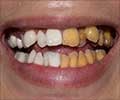Scientists have devised a new method of simulation that can enable a dentist to choose the best plastic fillings to close cavities, to prevent gaps from appearing between the tooth and the filling.
The plastic that dentists use to fill the cavity tends to shrink slightly as it hardens, occasionally producing tension that can cause tiny gaps to form between the filling and the tooth. Bits of food can get caught in these gaps and lead to more caries.Though manufacturers of filling materials offer a variety of plastics to choose from, dentists often find it hard to determine which filling is best suited to a particular shape of cavity.
“Until now, it has not been possible to establish a theoretical model of the hardening process. The tension occurring in the material always depends on the shape of the cavity, and can vary widely by a factor of up to ten, particularly at the edges,” says Dr.-Ing. Christof Koplin, research assistant at the Fraunhofer Institute for Mechanics of Materials IWM in Freiburg.
The researchers insist that their new method of simulation can enable tension in dental fillings to be accurately predicted, and thus be helpful to dentists in choosing the least tension-prone plastic for each shape of cavity.
They say that dentists can draw on the results of the IWM to select the best material, and manufacturers can use the simulations to optimise their products.
“We theoretically subdivide the dental filling into thousands of small parcels and calculate how each element affects its neighbour. Experimental parameters are incorporated in the individual elements. We started our laboratory tests by using a standard geometry to find out how each material reacts to the stresses that occur when the volume shrinks, and how the flow capability of the material changes as it hardens,” says Koplin.
Advertisement
Advertisement
SRM










